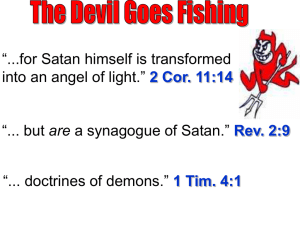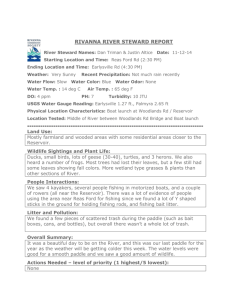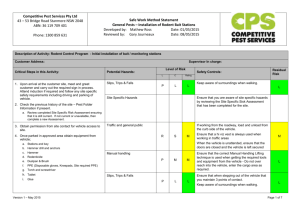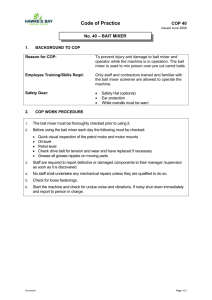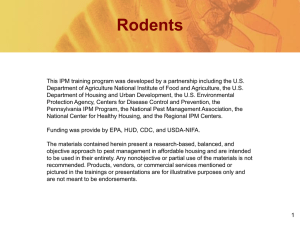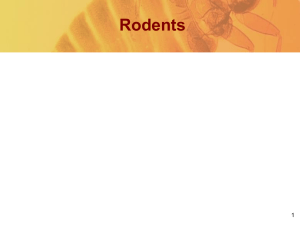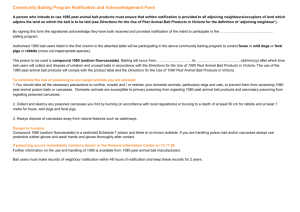Appendix D1 - rodent biosecurity procedures
advertisement
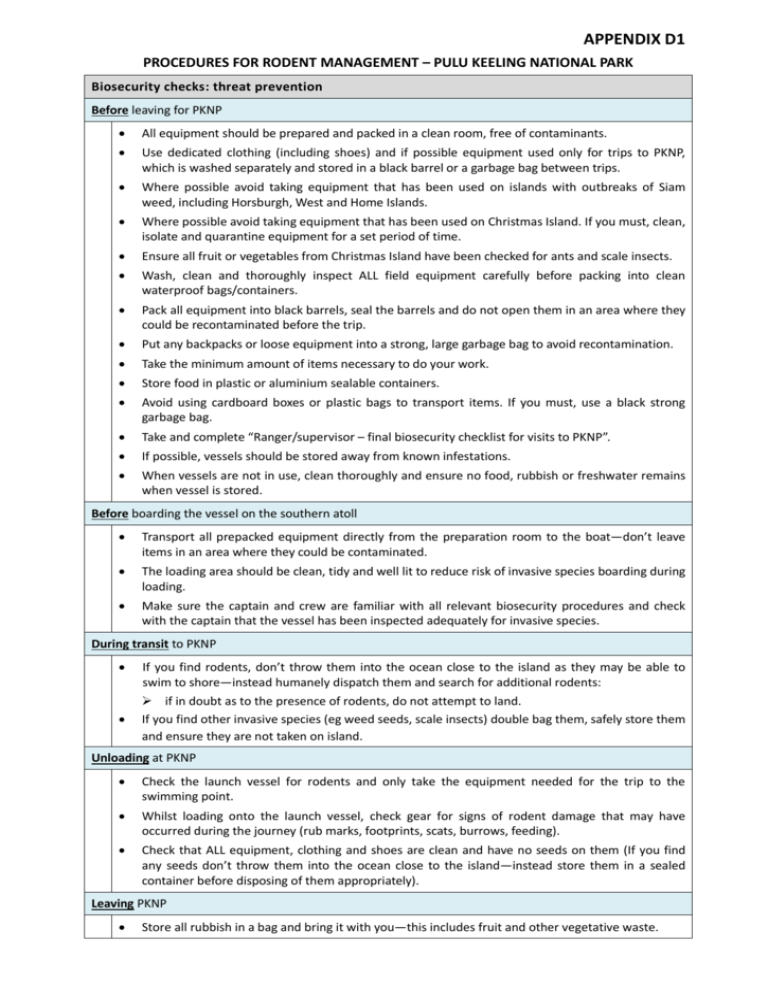
APPENDIX D1 PROCEDURES FOR RODENT MANAGEMENT – PULU KEELING NATIONAL PARK Biosecurity checks: threat prevention Before leaving for PKNP All equipment should be prepared and packed in a clean room, free of contaminants. Use dedicated clothing (including shoes) and if possible equipment used only for trips to PKNP, which is washed separately and stored in a black barrel or a garbage bag between trips. Where possible avoid taking equipment that has been used on islands with outbreaks of Siam weed, including Horsburgh, West and Home Islands. Where possible avoid taking equipment that has been used on Christmas Island. If you must, clean, isolate and quarantine equipment for a set period of time. Ensure all fruit or vegetables from Christmas Island have been checked for ants and scale insects. Wash, clean and thoroughly inspect ALL field equipment carefully before packing into clean waterproof bags/containers. Pack all equipment into black barrels, seal the barrels and do not open them in an area where they could be recontaminated before the trip. Put any backpacks or loose equipment into a strong, large garbage bag to avoid recontamination. Take the minimum amount of items necessary to do your work. Store food in plastic or aluminium sealable containers. Avoid using cardboard boxes or plastic bags to transport items. If you must, use a black strong garbage bag. Take and complete “Ranger/supervisor – final biosecurity checklist for visits to PKNP”. If possible, vessels should be stored away from known infestations. When vessels are not in use, clean thoroughly and ensure no food, rubbish or freshwater remains when vessel is stored. Before boarding the vessel on the southern atoll Transport all prepacked equipment directly from the preparation room to the boat—don’t leave items in an area where they could be contaminated. The loading area should be clean, tidy and well lit to reduce risk of invasive species boarding during loading. Make sure the captain and crew are familiar with all relevant biosecurity procedures and check with the captain that the vessel has been inspected adequately for invasive species. During transit to PKNP If you find rodents, don’t throw them into the ocean close to the island as they may be able to swim to shore—instead humanely dispatch them and search for additional rodents: if in doubt as to the presence of rodents, do not attempt to land. If you find other invasive species (eg weed seeds, scale insects) double bag them, safely store them and ensure they are not taken on island. Unloading at PKNP Check the launch vessel for rodents and only take the equipment needed for the trip to the swimming point. Whilst loading onto the launch vessel, check gear for signs of rodent damage that may have occurred during the journey (rub marks, footprints, scats, burrows, feeding). Check that ALL equipment, clothing and shoes are clean and have no seeds on them (If you find any seeds don’t throw them into the ocean close to the island—instead store them in a sealed container before disposing of them appropriately). Leaving PKNP Store all rubbish in a bag and bring it with you—this includes fruit and other vegetative waste. APPENDIX D1 Surveillance program During each visit On arriving at PKNP carry out a search of the landing area and the 2012 SIEV landing sites as per PKNP Invasive Species Detection Survey. During visits record any opportunistic live or dead sightings. Use rodent identification card to determine species. If possible take a photo. If a dead rodent is found seal in a zip lock bag and take to West Island for conclusive identification. Record location (GPS, bearings) of sighting. If camping overnight, set up 1-10 ink cards, snap traps and wax tags in and around the shed and original SIEV landing site. Retrieve at the end of the camping trip. Search for rodent activity (rub marks, footprints, scats, burrows, feeding) in and around the shed, original 2012 (and any new) SIEV landing sites and igloos. Undertake ongoing monitoring for rodents in and around the landing site by maintaining longterm rodent bait stations with cameras (using a non-lethal bait unless rats have been positively detected). See “incursion response” for instructions on placing bait stations and cameras. Annual inspections Undertake a comprehensive ink card survey to detect rodent activity and presence/absence. Record any opportunistic live or dead sightings. If a rodent is detected, start incursion control program. If a SIEV lands on PKNP Timing is critical and a team should be sent to PKNP as soon as possible to undertake biosecurity damage control. At the site, mark the location of the landing on GPS, take bearings and include in list of ongoing monitoring sites for each visit. Start a surveillance and control program at the landing site: lay Talon baits on all landed or moored SIEVs on PKNP setup cameras and a baiting array (refer to “incursion response” for bait type, station array and spacing, setting bait stations). If an incursion is detected Timing is critical and a team should be sent to PKNP as soon as possible to undertake biosecurity damage control. Suspected evidence of rodent incursion (rub marks, footprints, scats, burrows, feeding) should be preserved and independently verified by a rodent specialist. At the site, mark the location of the landing on GPS, take bearings and include details in list of ongoing monitoring sites for each visit. Setup cameras and a baiting array (refer to “incursion response” for bait type, station array and spacing, setting bait stations). If the initial control program does not stop a rodent population becoming established, start a full scale control program on the island1. Set up Pestoff bait stations across the entire island in a grid (1-2 stations and 10 kg per ha2). Ink cards or tracking tunnels, chew sticks, hair tubes could also be used to determine high use areas and ongoing population numbers. 1 Always consult experts in rodent control for advice or changes to best practice methods before launching the control program. 2 Island size is 1.2 km2=120 ha. Incursion response: control program NB: When planning the baiting operation, work out how much of each supply is needed to set up the required amount of buckets. Take enough baits, buckets, cameras (batteries, SD cards, straps) and have some spares. Before preparing bait stations for use on PKNP Baits brands/poison: 1. Racumin 8 (Coumatetralyl, 1st generation anticoagulant/ multiple take) 2. Talon (Brodifacoum, 2nd generation anticoagulant/ single take) Safety: Do not handle baits unless you have been trained in safe handling and use. All Personal Protective Equipment as identified in Standard Operating Procedures is required when handling baits. Always follow manufacturer’s instructions and the Material Safety Data Sheet (have English and Malay translations at site). If the MSDS or label is missing do not use the baits. Baits types – an explanation: see Addendum A When preparing baits for use Which bait type to use: LONG-TERM SURVEILLANCE PROGRAM Racumin- multiple takes bait. SIEV LANDING OR INCURSION DETECTED Talon- single take bait. When setting bait stations on PKNP Bait station arrays and spacing: Bait in a 1 km radius from the landing/incursion for rats bait lines – 100 m apart, bait stations – 50 m apart for mice bait lines – 25 m apart, bait stations – 15 m apart. NB: bait stations and traps should not be placed in water. Preparing a bait station for the first time: On site : mark site of bait station using GPS and flagging tape/spray paint. Record the following on datasheet: number the bait station to allow data to be related to the site person/s, date, time, bearings (lat/long), weather conditions the amount and type of bait used per bucket*. Place three bags of bait into the white bucket. Only use new bags of bait to maintain palatability. Close the bucket and check that the seal is closed to minimise water leaks and reduce impacts to non-target species. Mark the baited areas on the map. If placing a camera: Open the faunatech camera. Insert eight batteries. Mark the SD card with the station number and place inside the camera. Check the camera is turned on, set the date and time using the menu and arrows. Set to record, check it is functioning and close the cover. Camera placement: locate ~60 cm from the ground and ~3 m back from the target area, position/tilt to gain maximum visual capacity and reduce the chance of damage from flooding. 2 Maintenance/re-baiting existing stations: Check bait stations for activity during every visit to the island. Ensure all empty packets are removed using gloves, bagged and taken off the island for disposal. Refill bait if required, up to three packets. If ants are accessing and monopolising the bait, spray a Coopex mix around the entrance. Record the following on datasheet: bait station number person/s, date, time, bearings (lat/long), weather conditions any visible impacts to non-target species on datasheet in-bucket activity (rub marks, footprints, scats, burrows, feeding, chewing around the access hole, blood, deceased rodents) the amount of bait bags replaced*. If the site has cameras: open the camera replace all eight batteries (if not possible record the which batteries were replaced e.g. bottom two) take the SD card from the camera (check it is marked with the station number) replace the SD card (mark with the station number) check the camera is turned on and functioning close the cover. * Record the amount and type of bait used at the end of each day and the total used on each trip. 3 Equipment required (additional to Personal Protective Equipment) Kits should be stored on West Island for immediate availability Surveillance: Control: Datasheets digital camera/s faunatech cameras, straps and remotes (if needed) Racumin bait in 0.5 kg packets (stored on PKNP and replenished) coconut milk or other attractant in spray bottles Coopex insecticide AA batteries, four per camera (take spares) Talon bait in 0.5 kg packets (stored on PKNP and replenished) datasheets Chemical/plastic gloves GPS 15 L white lidded buckets with 6 cm circular holes, at the height where the bucket handle is positioned. Remove handle to exclude hermit crabs from bucket. rodent identification card maps of PKNP with lat/long gridlines SD cards Large/medium size plastic zip lock bags rodent identification card GPS Items listed over for control program to set long-term monitoring buckets Review/debrief process (post trip) As per PKNP Communications Plan—notify the emergency contact officer that you have returned, ensure all staff are safe and accounted for, any noteworthy incidents are reported. Address any issues/problems with the process. Enter any data collected. Service and clean equipment if required and return all equipment to secure hygienic location. Restock/replace bait and other stores if necessary. Document activity—what was achieved, when, by whom, resources used, any biosecurity breaches. 4 Addendum A RAT POISONS EXPLAINED (Sources: Lord Howe Island Board 2009; Eason & Ogilvie 2009; Hone and Mulligan 1982; Putman n.d.) Rat poisons are generally classified into two types: 1. non-anticoagulant acute poisons (NOT IN USE) 2. anticoagulants (RACUMIN and TALON). Non-anticoagulant acute poisons: are typically single-dose poisons that act rapidly can produce symptoms within one hour and death within a few hours when a lethal dose is eaten rarely result in 100% mortality of the target species are non-selective (i.e. they don’t just kill one species) use declined dramatically in the 1950s after the introduction of anticoagulant poisons examples include zinc phosphide, cholecalciferol, strychnine and sodium monofluoacetate (sold as 1080). Anticoagulants: are substances that stop blood from clotting are either single-dose or multiple-dose poisons that act slowly usually produce symptoms a few days after being eaten are extremely effective because rodents don’t link eating the bait to getting ill—by the time symptoms start they have already eaten a lethal dose are separated into first-generation and second-generation types: First-generation anticoagulants were developed between 1940 and 1960. They include warfarin, diphacinone, pindone and coumatetralyl. They are generally low toxicity but need a high concentration and several feeds over a number of days to kill their target. Second-generation anticoagulants were developed in the 1970s and 1980s. They include brodifacoum. They were developed partly because rodents became resistant to firstgeneration types. They are more toxic so require lower concentrations and only a single feed to kill rodents. 5


